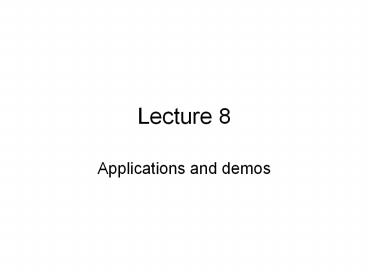Applications and demos - PowerPoint PPT Presentation
Title: Applications and demos
1
Lecture 8
- Applications and demos
2
Building applications
- Previous lectures have discussed stages in
processing algorithms have addressed aspects of
language modelling. - All but the simplest applications combine
multiple components. - Suitability of application, interoperability,
evaluation etc. - Avoiding error multiplication robustness to
imperfections in prior modules.
3
Demos
- Limited domain systems
- CHAT-80
- BusTUC
- OSCAR Named entity recognition for Chemistry
- DELPH-IN Parsing and generation
- Automatic construction of research web pages
- Rhetorical structure Argumentative Zoning of
scientific text - Note also demo systems mentioned in exercises.
4
CHAT-80
- CHAT-80 a micro-world system implemented in
Prolog in 1980 - CHAT-80 demo
- What is the population of India?
- which(Xexists(X(isa(X,population)
and of(X,india)))) - have(india,(population574))
5
Bus Route Oracle
- Query bus departures in Trondheim, Norway, built
by students and faculty at NTNU. - 42 bus lines, 590 stops, 60,000 entries in
database - Norwegian and English
- in daily use half a million logged queries
- Prolog-based, parser analyses to query language,
mapped to bus timetable database - BusTUC demo
- When is the earliest bus to the airport?
- When is the next bus from Dragvoll to the centre?
6
Chemistry named entity recognition
- SciBorg OSCAR 3 system recognises chemistry
named-entities in documents - (e.g. 2,4-dinitrotoluene citric acid)
- Series of classifiers using n-grams, affixes,
context plus external dictionaries - Used in RSC ProjectProspect
- Also used as preprocessor for full parsing
- Precision/recall balance for different uses
7
Enhanced browsing of chemistry documents RSC
using OSCAR
8
Precision and recall in OSCAR from Corbett and
Copestake (2008)
High precision, modest recall text viewing
Modest precision, high recall text preprocessing
9
(No Transcript)
10
DELPH-IN
- DELPH-IN informal consortium of 18 groups (EU,
Asia, US) develops multilingual resources for
deep language processing - hand-written grammars in feature structure
formalism, plus statistical ranking - English Resource Grammar (ERG) approx 90
coverage of edited text - ERG demo
- Metal reagents are compounds often utilized in
synthesis.
11
(No Transcript)
12
(No Transcript)
13
(No Transcript)
14
Some uses of the ERG
- Automatic email response (YY Corp, commercial
use) - Machine Translation
- LOGON research project Norwegian to English
- smaller-scale MT with other language pairs
- Semantic search
- SciBorg (chemistry, research)
- WeSearch (Wikipedia, University of Oslo, new
research) - English teaching (EPGY, Stanford 20,000 users)
- http//www.delph-in.net/2010/epgy.pdf
- Smaller-scale projects in question answering,
information extraction, paraphrase ...
15
Application- (and maybe domain-) specific
Application and domain- independent DELPH-IN Tools
16
Automatic web page generation
- Using publication lists to find links between
people and to construct summaries - Generating research websites using summarisation
techniques gives NPs like summarisation
techniques - cluster these terms
- locate co-authors, summarise collaborations
- Web page generation demo
17
Collaboration summaries
- Lawrence C Paulson collaborated with Cristiano
Longo and Giampaolo Bella from 1997 to 2003 on
formal verification, industrial payment and
nonrepudiation protocol, kerberos
authentication system and secrecy goals and in
2006 on cardholder registration in Set and
accountability protocols.
18
Argumentative Zoning
- Finding rhetorical structure in scientific texts
automatically - Research goals
- Criticism and contrast
- Intellectual ancestry
- Robust Argumentative Zoning demo
- input text (ASCII via Acrobat)
- Usages search, bibliometrics, reviewing support,
training new researchers
19
(No Transcript)
20
NLP Course conclusionsTheme ambiguity
- levels morphology, syntax, semantic, lexical,
discourse - resolution local ambiguity, syntax as filter for
morphology, selectional restrictions. - ranking parse ranking, WSD, anaphora resolution.
- processing efficiency chart parsing
21
Theme evaluation
- training data and test data
- reproducibility
- baseline
- ceiling
- module evaluation vs application evaluation
- nothing is perfect!
22
Modules and algorithms
- different processing modules
- different applications blend modules differently
- many different styles of algorithm
- FSAa and FSTs
- Markov models and HMMs
- CFG (and probabilistic CFGs)
- constraint-based frameworks
- inheritance hierarchies (WordNet), decision trees
(WSD) - classifiers (Naive Bayes)
23
More about language and speech processing ...
- Information Retrieval course
- MPhil in Advanced Computer Science
- language and speech modules
- in collaboration with speech group from
Engineering - http//www.cl.cam.ac.uk/research/nl/postgrads/
- http//www.cl.cam.ac.uk/admissions/acs/modules/































